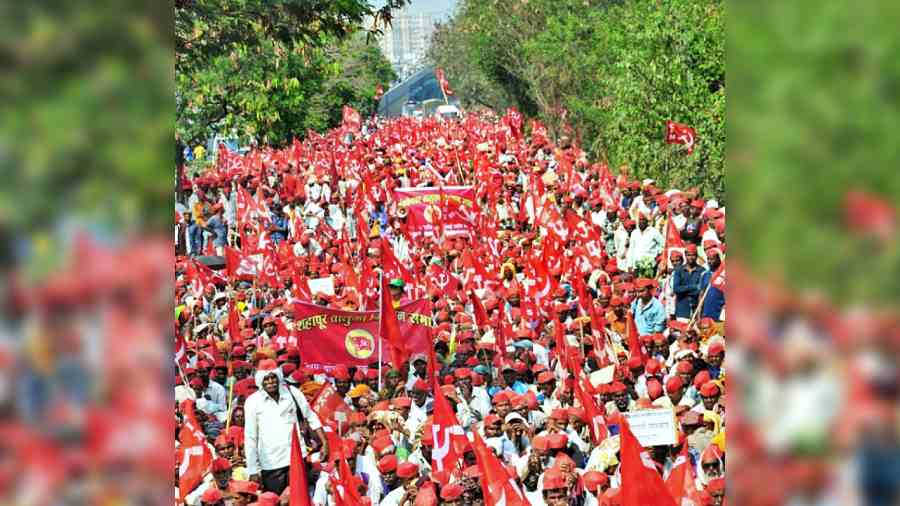Capitalism, like slavery and feudalism earlier, is characterised by the existence of two antagonistic classes, the capitalists and the proletariat. But any actual society, including what everyone would identify as a capitalist society, differs from this conceptual model of capitalism in including a multiplicity of classes, both owing to the admixture of earlier modes of production and also because within capitalism itself the two classes proliferate into more, each with its own specificities. The changing relations between the two basic classes and these other classes constitute the story of the political economy of such a society, just as the extent to which either basic class enlists the support of these other classes determines the outcome of class struggle at any juncture.
Lenin’s perspicacity lay in seeing the possibility of workers enlisting the support of the peasantry in the revolutionary agenda; while Mao Zedong’s remark about “correct handling” that turns an antagonistic into a non-antagonistic contradiction, referred not to the basic classes, whose antagonism is abiding (except when imperialism becomes a common enemy), but to the working class’s handling of these other classes.
From this perspective, the central issue in post-Independence Indian political economy has been the relationship not so much between the (big) capitalists and the working class, which has run along predicted lines, as between the peasantry and the urban middle class. The hallmark of the dirigiste ‘Nehruvian’ development strategy was its relative autonomy vis-à-vis what can be called metropolitan capital, in which building up the public sector was a key element; but this strategy was made viable by the fact that it was supported by both the urban middle class and the peasantry, which also ensured that even the big capitalists, notwithstanding any predilection for making common cause with metropolitan capital, fell in line behind it. With the working class, too, supporting this strategy that the Left considered ‘anti-imperialist’, the broad class alliance that had fought the anti-colonial struggle, remained intact behind the Nehruvian strategy.
The high point of this strategy was the nationalisation of banks in 1969 that made possible its second main achievement, import substitution in foodgrains (the first had been the building of a techno-industrial base under Nehru). The peasantry got substantial institutional credit; the middle class got significant employment opportunities because of the extension of bank branches; and even the capitalists got more credit under the new dispensation than they would have got earlier from their captive banks.
One can identify several weighty reasons for the collapse of this strategy: the fiscal crisis of the Indian State; the formation of large blocs of finance in metropolitan banks that offered, in the event of a strategy change, an easy way of financing the perennial current account deficits of the country and so on. But reinforcing these proximate factors was something fundamental: a change in the attitude not just of the big capitalists but also of the urban middle class. The Nehruvian strategy had greatly enlarged the numbers of skilled and technical personnel; the opportunities unfolding in the metropolis attracted them, and they wanted such opportunities created at home too through the outsourcing of activities from the metropolis, as had happened in East Asia. They saw the Nehruvian strategy as standing in the way, and wanted it replaced by neo-liberalism.
Neo-liberalism, however, immiserised the peasantry. In the name of fiscal ‘adjustment’, it curtailed subsidies to agriculture; it opened up agriculture to world market price fluctuations; it removed any minimum support price for cash crops; it effectively curtailed institutional credit to agriculture, making credit far more expensive; it wound up public extension services and opened agriculture to international agribusiness. All these made peasant agriculture both unprofitable and precarious. The suicides of lakhs of peasants and the reduction in the number of ‘cultivators’ by 15 million between the 1991 and 2011 censuses, reflected this immiserisation. Neo-liberalism thus not only split the class-alliance carried over from the anti-colonial and caused a hiatus between the urban middle class and the peasantry, but also actually pitted them against one another.
The tragedy of the Indian Left is that it underestimated this contradiction. To its great cost, it succumbed to middle class pressure for industrialisation within the neo-liberal paradigm, even when the peasantry opposed it; it made no attempt to overcome this contradiction and reconcile the interests of both classes in an innovative manner, by promoting, for instance, peasant co-operative-owned township and village enterprises, and other such forms. It is only with its unstinted support for the yearlong kisan agitation that a rectification of sorts was effected by it, though, given the peasantry’s proverbial long memory, winning back its confidence will be a prolonged effort for the Left.
Neo-liberalism, however, has reached a dead end, though the urban middle class continues to put its trust in it and is even willing to put up with neo-fascism with whose help neo-liberalism is trying to overcome its existential crisis. Neo-fascism cannot be defeated without transcending neo-liberalism; and this transcendence requires reuniting the peasantry with the urban middle class through a development strategy that combines primacy for agriculture with industrialisation, which is oriented towards the home market and hence thrives on the prosperity of the peasants and agricultural workers. It requires setting up industrial units that, instead of evicting peasants, are collectively owned by them. The contradiction between the peasants and the urban middle class, as Mao would have put it, must be made non-antagonistic.
Prabhat Patnaik is Professor Emeritus, Centre for Economic Studies, Jawaharlal Nehru University, New Delhi










